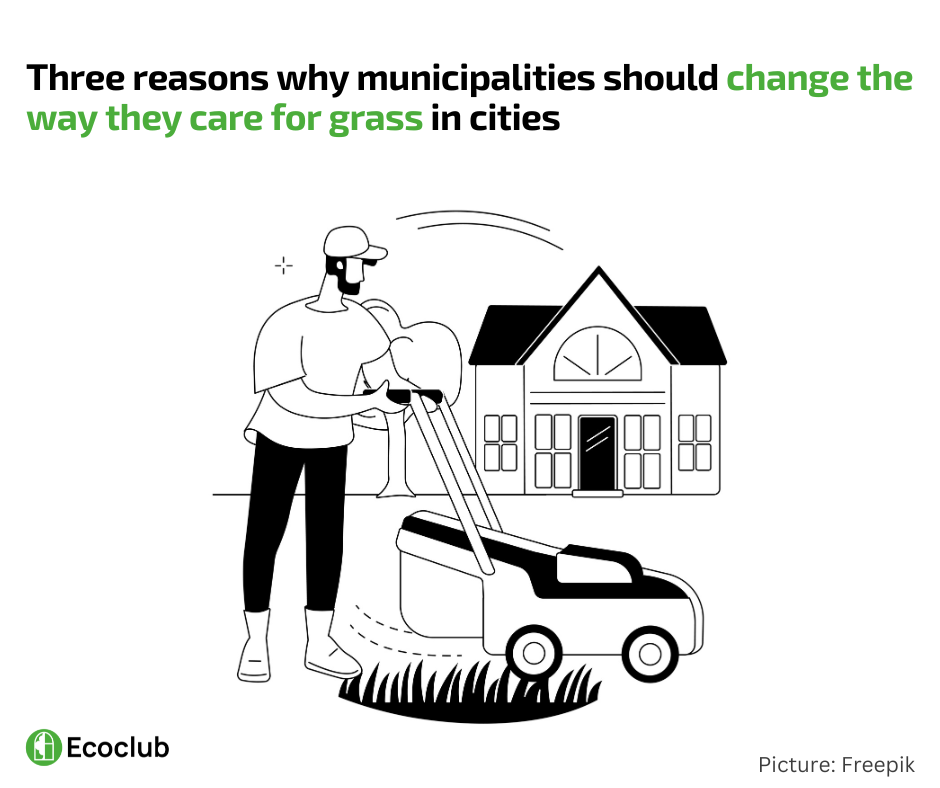Ukrainian communities have been working to rebuild even before the victory. Municipalities that implement climate change adaptation measures will find it easier to attract funding and find partners in the future. After all, including climate change vulnerability assessments and adaptation measures is a mandatory component of many European infrastructure projects.
Changing approaches to mowing grass in cities will help adapt the community to climate change, preserve biodiversity, and save budget funds.
How do mowing approaches affect the comfort of urban residents? What types of plants are best to plant? Why are meadows the best alternative for landscaping in war-affected communities?
1. Adaptation. Green space maintenance and climate change
Grass cover affects air purity, reducing street flooding, dust storms, and other factors that indicate a community’s vulnerability to climate change.
According to the most optimistic forecasts, the upward trend in average annual temperature will continue and increase over the years. The Strategy for Environmental Security and Adaptation to Climate Change for the period up to 2030 and 2040 predicts an increase in the average annual temperature in Ukraine within 0.8-1.1 °C and an increase in the redistribution of precipitation throughout the year by ±20%, with an increase in the cold season and a decrease in the warm season.
Increasing temperature will affect green spaces, whose poor condition exacerbates the possible consequences of abnormal weather events.
“Degraded vegetation cannot retain or absorb rainwater, especially during heavy rain. And where proper vegetation management could have avoided flooding or even puddles on sidewalks, we see the opposite situation. Therefore, communities need to solve the problems associated with frequent and poor-quality mowing and develop a new grass care plan that will meet the principles of the European Green Deal,” says Olha Liashchuk, project coordinator at Ecoclub.
2. Restoration. What is best for post-war urban landscapes
Grass cover in cities is more than perfect for low-mown lawns. They are not a sustainable solution; they cannot regenerate themselves and do not contribute to the maintenance of biodiversity. European cities are increasingly abandoning the repeated mowing of lawns and favoring meadow grass. It requires less mowing and provides a haven for insects and small animals, increasingly losing their habitats due to urbanization and dense urban development.
Advantages of meadow grass cover:
- Easy to maintain
- Reduced annual maintenance costs (mowing, watering, etc.)
- Maintaining the urban ecosystem and biodiversity
- Aesthetic solution for urban landscapes
- Formation of dense and stable turf that protects the soil from erosion
- It improves the climate in the city and provides additional coolness at night
- Preserves soil moisture
- Retains excess water
“Ornamental meadows can be a great alternative to lawns in the post-war urban landscape. They will quickly green the area and do not require a lot of resources. The meadows will allow communities not to abandon landscaping activities even in the face of post-war resource shortages. They will also help to dispose of the construction waste generated as a result of the destruction: in crushed form, it can be used as a basis for meadow plantations,” says Maria Golyuk, landscape architect at Masshtab
3. Money. Experience of cities: how much Lviv loses on mowing and Vinnytsia saves
Different types of mowing can be easily applied on the same territory to reduce the negative impact on the environment and create a space with varying grass and plant height structures. When defining separate zones for different types of mowing, you need to consider the environment (the need to conserve water and maintain biodiversity), the site’s function, and the work’s final visual effect. Such zones can be marked with information boards to facilitate the exchange of information between residents and those responsible for maintaining the territory.
For example, in Vinnytsia, the municipal enterprise “Institute of Urban Development” experimented last year: they restricted mowing on a 4,000 square meter area between the carriageways. They monitored the condition of the grass cover during the season, found out how much money they would save in the long run, and interviewed community members.
The proposed maintenance involves reducing mowing from four to five times to two times a year. The savings per season will be between UAH 8,000 and 12,000 (with the market price of mowing at UAH 1 per square meter, a single mowing of this area will cost UAH 4,000).
In July-August of the same year, more than a thousand residents of the Vinnytsia community were surveyed. As a result, more than 90% would like to see more meadows in the city, while 71% of respondents are concerned about the operation of brush cutters. The survey also revealed a request from the townspeople to improve the quality of landscaping: replacing lawns with shrubs and shade-tolerant plants.
“Based on the survey results, we agreed to restrict mowing in two more city areas. Also, in cooperation with the Polish EID Foundation, we created a sowing meadow on the central alley of the park,” says Liubov Kolosova, an expert on ecology and landscaping, Municipal Enterprise “Urban Development Institute,” Vinnytsia.
In Lviv, the NGO Plato is studying lawns. They are looking at grass cover in the context of climate change adaptation. They also investigated how much the Lviv community spends on mowing lawns. In 2022, the cost of such work was UAH 18 million 800 thousand (excluding parks).
“In 2021, my team and I also tried to restrict mowing in Lviv partially: we cooperated with the district administration, agreed on the areas, and installed information signs for the public. However, the experiment lasted less than a day: after the first call to the administration’s hotline, the administration asked us to continue mowing as usual. This made it clear that quick fixes for this situation are not effective. We need to work on changing values with the population and form a public demand,” says Anzhelika Zozulia, coordinator of nature-based projects at NGO Plato, co-founder of the urban gardening and horticulture space Rozsadnyk.
Communities can start planning comfortable urban spaces now, include them in their recovery plans or Sustainable Energy and Climate Action Plans (SEAPs), and implement sustainable mowing practices.
Urban green spaces should be designed considering their location and functional purpose. This will allow for different plantings, optimizing the loss and conservation of natural and human resources.
The article was written within the framework of the projects “Closing the Loop: A Just Energy Transition Designed by Cities and Regions,” implemented with the financial support of the European Union; “Building the Ecofeminist Movement”, funded by WECF International (Women in Europe for a Common Future); and “Enhancing the Institutional Capacity of the Ecoclub in the Light of Post-War Reconstruction and EU Candidate Status” within the framework of the Environmental Policy and Advocacy Initiative for Ukraine, implemented by the International Renaissance Foundation with the financial support of Sweden.
Opinions, conclusions, or recommendations are those of the authors of this paper and do not necessarily reflect the views of the European Commission, WECF International, and the Government of Sweden. The content of this document is the sole responsibility of the NGO Ecoclub.












